India’s upcoming lunar mission, LUPEX, scheduled to launch in the next few years in collaboration with Japan, is set to serve as a precursor to the country’s ambitious lunar sample return mission, according to Anil Bharadwaj, Director of the Physical Research Laboratory (PRL). In a public lecture on the Lunar Exploration Program of India, Dr. Bharadwaj highlighted the strategic importance of LUPEX in advancing India’s lunar exploration capabilities.
The LUPEX mission, a joint initiative between India and Japan, aims to explore the permanently shadowed regions or the dark side of the moon. The launch vehicle for the mission will be a Japanese rocket, with ISRO developing the lander system and Japan Aerospace Exploration Agency (JAXA) contributing the rover. The mission’s landing point is planned for the south pole of the moon.
Dr. Bharadwaj emphasized that LUPEX is a crucial step in India’s lunar exploration journey, serving as a testing ground for future sampling missions and paving the way for the country’s aspiration to send the first Indian to the moon by 2040. The mission’s objectives include exploring the permanently shadowed regions, where sunlight never reaches, to unravel the mysteries of these areas.
The successful execution of LUPEX will contribute valuable insights for India’s lunar exploration strategy, especially in the context of future missions involving human landing on the moon. Dr. Bharadwaj highlighted the successful performance of scientific payloads on board Chandrayaan-3, showcasing the progress made in India’s lunar exploration endeavors.






